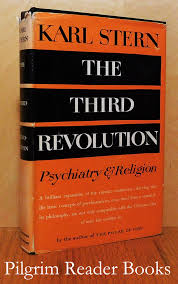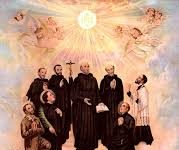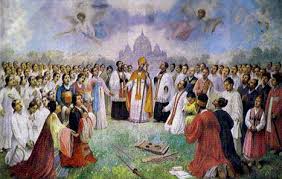“On the deepest, ontological level, it is true that where there is Neurosis there is something wrong with Faith, Hope, and Charity.” Karl Stern
Karl Stern (1906-1975) was a German psychiatrist of the psychoanalytical school founded by Sigmund Freud. Born a Jew, in his teen years he became an atheist, but later reverted to Orthodox Judaism after undergoing psychoanalysis. In 1936 he emigrated from Germany to England and from there to Canada, where in later years he taught at McGill University and the University of Ottawa. At the age of 37, after conversing at length with the philosopher Jacques Maritain and the Catholic Worker Movement’s Dorothy Day, Stern was baptized a Catholic. His life and conversion are documented in his autobiography Pillar of Fire, wherein Stern relates his first private meeting with Maritain at a mutual friend’s house in Montreal. “Since I spoke almost in a whisper he had moved up closely and spoke also in a whisper…. I had from the first moment the deep impression of a strange and pleasant form of personal directness which was the result of great charity and humility…. I could just as well have been inside the catacombs, a helpless catechumen whispering to an apostle.”
In 1954 Stern published The Third Revolution: A Study of Psychiatry and Religion. In the early chapters he treats the origins of Psychoanalysis and the language invented by Freud to discuss its principles and applications. The discovery of Psychoanalysis, Stern declares, followed two great revolutions in human thought that might be considered two great assaults on the dignity of the human person born into a Judaeo-Christian world. The first great revolution was the Copernican theory of the solar system, which asserted that the universe was not created with the earth as its center. Thus, man’s home is not and never was the centerpiece of all creation. Then came the second great revolution: Darwin’s theory of evolution, which asserted a comparable demotion of man to just one of many species that emerged from a long and tedious process of Blind Chance wending life’s way from the first simple organisms to the present infinitely more complex ones.
Chapter six zeroes in on the third great revolution: Freudian Psychoanalysis, which according to Freud himself was built on the premise that Man is not the darling of God’s eye because there is no God in the first place. The fatal flaw in this kind of thinking, Stern notes, was that Freud had set up shop as a philosopher as well as a psychiatrist. In spite of Freud’s immature theological rambling into the heresy of atheism, Stern finds great merit in most of Freud’s theories of Psychoanalysis, some of which he regards as compatible with the Christian view of our human nature. Whatever there is in psychoanalysis that can be empirically proven is true, and is therefore a part of Truth itself. But atheism at its core obviously cannot be empirically proven. It is for his views on religion that Freud’s brand of psychoanalysis came to be viewed as hostile to religion. What exactly were those views?
Freud on Religion
Stern argues that Freud’s views on religion can be reduced to two major points of attack. The first is that God is imagined as a Father figure, and this illusion is based upon the fact that our human fathers serve as the prototype for the heavenly Father who is creator, rewarder, and punisher. However, the human father invariably comes to be viewed as greatly flawed. Summarizing Freud, Stern says:
In the degree to which the child develops a grasp of reality, that image of the father is gradually erased. Instead of it, a fantasy figure, a father in heaven, becomes imbued with the same qualities of omnipotence and protectiveness….. In other words, God is nothing but the father …. In fact, anything in the spiritual order is ‘nothing but.
This is quite logical for Freud. If one denies the existence of any things beyond the natural world, the only possible conclusion is a philosophy of ‘nothing but,’ a philosophy of debunking. This is common to all materialist trends of the nineteenth century…. To a modern astronomer the earth is nothing but an insignificant speck in the galaxy; to the biologist man is nothing but some chance product of an evolutional process which has no transcendental meaning; to a dialectical materialist cultural achievements are nothing but by-products of the economic struggle.
Freud’s second line of attack on religion consists of his viewing it as an obsessive-compulsive neurosis. He likens the rituals of religion to those observed in neurotics who cannot resist the repetition of apparently irrational acts, such as too frequent hand-washing, or avoiding the touch of certain objects, or compulsively touching other objects. Freud believed this phenomenon of ritualistic behavior was typical of all the major religions, and therefore these religions could be viewed as obsessive-compulsive behavior on a mass scale. Freud saw this behavior as rooted in infantile experiences; it is often noted that children are drawn to repetitious acts, the kind of ritual behavior that would be considered immature if found in adults. From this, Freud’s concludes that at some early infantile period of human history religion first took hold among adults and never relinquished its influence over the management of human societies. The ritual slaughter of animals to be sacrificed to God, for example (a rite commonly found in all ancient religions), might be connected with guilt feelings that drive the Oedipal conflict between fathers and sons. This would be a primitive trauma that would have established itself among humans eons before the story of Abraham preparing to slaughter his son as a sacrifice to God. The pattern is repeated and amplified in Christianity when the slaughter of Jesus as a sacrifice to God the Father induced horrible guilt feelings among Christians, memorialized by them in the yearly pageant of the Passion plays and most of all in the Catholic Mass, a daily ritual for thousands of years.
Stern Critiques Freud
The problem, as Stern sees it, is that there is nothing the least bit scientific about Freud’s debunking of religion, nor is there anything scientific about his reduction of the sacrificial elements in Judaism and Christianity to a patricidal struggle between the father and the son that must be resolved by the son being sacrificed to the father. If anything, Freud as atheist was really engaged in a patricidal struggle of his own to kill the Hebrew God the Father and the Christian God the Son by denying that either ever existed and were always mere phantoms invented by neurotic primitive myth-makers. Had Freud looked inward, he might have seen his own conflicted feelings about his own human father as the basis for his revolt against God. Freud’s psychological Deicide is difficult to distinguish from that psychological Deicide committed by Nietzsche in his famous saying, “God is dead.” Stern concludes that Freud’s explanation for the neurotic origins of religion would not be accepted as scientific by any of the scientific materialists of his own day, who prided themselves on empirical evidence, rather than pure speculation, to assert any truth that is supposed to explain human behavior.
Freud’s debunking notion that religion is “nothing but” can only be explained by the idea of sublimation, which is the suppression of true animal instincts transformed into artificial ones that are more ideal rather than mechanistic. But if we take Freud literally, we run smack up against a brick wall when trying to explain any other ideal goals to be pursued. “The very formation of the concept of sublimation implies the existence of something beyond it. Does anyone really believe that families are founded, orphans are cared for, the sick are tended to, cathedrals are erected, symphonies are composed only because instinctual drives are blocked [sublimated] by society?” What sublimated drives would Freud be talking about? The ones traditionally viewed as grossly selfish and even demonic? Those are the ones Freud himself talked about as hiding in the dark recesses of the Id? Would Freud have us believe that the ancient Greek play Oedipus Rex was really a sublimation of Sophocles’ mother fixation?
Stern notes, “It has frequently been pointed out that in Marx’s philosophy of history, with the proletariat, the down-trodden class, in the role of a saviour there is something like a prophetic and messianic afterthought, not at all in step with dialectics. There is something similar the matter with Freud’s theory as to how religion came about.” In plainer words, Stern argues that Marx and Freud both probably saw in their work a redeeming deliverance somewhat akin to the redeeming deliverance associated with the mission of Jesus Christ. But if that is so, why not conclude that the redeeming mission of Jesus is the prototype of all other so-called redeeming missions? Perhaps Marx and Freud are just twisted versions of that divine prototype for our final deliverance? Perhaps the redeeming missions of both Marx and Freud are “nothing but” alternative versions of a truer and more transcendental need for redemption planted by God in every human psyche. If so, the question that remains and needs to be answered is this: why is modern man so aggressively drawn to the de-spiritualization of our profound need for redemption.
Freud, Darwin, and Marx
The forays of science into theology and philosophy, such as Freud, Marx, and the disciples of Darwin conducted when they sought to make atheism respectable, more than made up for the forays of theology into science in the case of Galileo and the hostile reaction of Christians to Darwin’s theories. According to Stern, there is a direct link between Darwin and Hitler. “Darwin’s theory of the survival of the fittest has to be judged on its own merits, as a scientific hypothesis. It referred to animals, not to men. But it contributed, quite independently of the intentions of its originator [Darwin was not an atheist], to something which one might call the climate of our times.” That climate was no doubt encouraged by the likes of Nietzsche’s Superman philosophy, along with Wagner’s and Schopenhauer’s “death magic.” World War I was just a warm-up act for World War II, which superbly proved the lunacy of the Superman hypothesis and the Nazi fallacy that Germany was the “fittest to survive.”
Freud was a psychological determinist, Marx a historical determinist. Darwin was a biological determinist in that evolutionists see not will, but on the contrary blind chance at work in evolution. All three schools of thought follow the Cartesian model of the human machine. All three, but especially Freud, regarded free will as a delusional aspect of our human destiny. Even Pavlov and the behaviorists who succeeded him did not hesitate to board the determinist train of modern philosophy. Behavioral psychologist B.F. Skinner went further than Freud by laying the determinist foundations for social engineering in his books Walden II and Beyond Freedom and Dignity (the title of the latter book suggests an unscientific fusion of philosophy and psychology similar to what Freud practiced.) Skinner’s model for social engineering has been adopted and successfully executed by corporations willing to use it to increase sales of their products (example, chewing gum manufacturers subtly suggest in their ads that chewing gum relaxes and relieves anxieties). Orwellian mass manipulation in political ads has been proven to be especially effective. To the extent that such ads are deceptive and dishonest, the apparent alliance of social engineering with the media indicates a conspiracy to foil the Eighth Commandment (forbidding false witness), and a visible contempt for spiritual values. One may, of course, join one’s science with one’s philosophy, but in doing so he should be honest with himself about whether his philosophy is noble or base. And if one refuses to be honest about this, one’s critics are surely entitled to weigh in.
Comtean Psychology Revived
The fundamental problem of this third revolution, Stern argues, is that modern science tends to regard itself as the exclusive guardian of knowledge and wisdom, and in particular the wisdom that governs the morality of human actions. Having repudiated the authority and revealed tradition of ancient religious wisdom, science has claimed for itself a herculean task to build a new path to the noble and the meaningful life (everlasting life is not even on its agenda, even if increasing earthly longevity is). As Stern puts it: “Under the Comtean idea of a science of man, disciplines which methodologically do not necessarily fit together, such as psychoanalysis and behaviorism, anthropology and psychology, psychiatry and sociology, form a kind of unified structure. They are held together by a common philosophical basis. They are beginning to form a sort of Corpus Non-Mysticum. The fulfillment of Auguste Comte’s dream of a world dominated by science is not far off.” Indeed, the futuristic novels Brave New World by Huxley (in which drugs dominate public consciousness) and 1984 by Orwell (in which Big Brother knows everything by way of cameras and recorders) have been fulfilled.
Freud supported the positivist conclusion that, where the achievement of morality and happiness and social peace and justice are concerned, science, not religion, will carry the day. It is difficult to see how, when we look around us, anything like that has happened. While it may well be true that religion is in decline, it does not seem at all true that science has assumed its mission or materially contributed to organizing mankind’s pursuit of the good and happy life. On the contrary, Stern asserts: “The world is full of mental anguish. Our mental hospitals cannot cope with the number of patients who seek admittance. Alcohol and drug addiction are on the increase; so is the number of broken marriages. All these are signs that men are torn by irrational fear and hatred.”
Even so, Stern insists, “That Comtean edifice of which I spoke is already so vast that our Catholic critics come to overlook a simple fact. The psychoanalytical method in itself can be made philosophically neutral. There exist a number of psychiatrists, with a Christian set of beliefs, who use psychoanalytical methods with great advantage.” However, Stern asserts, there is no use fooling ourselves. The dominance of positivism among psychoanalysts is obvious: “… there is no doubt about it: the communications expert who abolishes ‘value concepts’ and other ‘old-
fashioned alternatives’; the sociologist who rejects the Christian concept of love in favor of more up-to-date psychoanalytic findings; the general who abolishes traditional morality for the establishment of a ‘peace-time society’; the ‘amoralist’ who advocates a ‘really new education for social living’; the social psychologist who investigates scientifically how to soothe the frustrations of coal miners; the zoologist who informs us about the true origins of sexual morality … they all belong together. They are signposts on the way. Ahead of us lies the fantastic possibility of a world in which human happiness is technically assembled. In that Comtean revolution there are no atrocities. There are no martyrs. Man, the image of God, is led to a painless death.”
Freud versus Jung
Chapter ten of The Third Revolution is titled “Psychiatry and the Life of the Spirit.” Here Stern is concerned to demonstrate that the great divide between psychiatry and spirituality can be tested in the case of those visions declared to be experienced by various Catholic saints throughout history. From the atheist psychiatrist’s point of view, the “nothing but” hypothesis kicks in; namely, that such visions are “nothing but” delusional moments produced by some psycho-chemical disturbance or by a perverse creation of the unconscious mind which intrudes upon the conscious self with fantastic images and messages. Carl Jung, originally a follower of Freud, broke with Freud precisely on this point. The unconscious mind for Jung was not just a storehouse for memories and images, but also a source of creative activity that could not be explained in natural terms alone. Thus Jung discovered what he later called the archetypes of the unconscious mind, memories and images that are primitive in the human race, that belong to the collective unconscious of the race, and that are transmitted from generation to generation since the dawn of human history. By this theory Jung introduced the possibility of reconciling religion with psychiatry. The archetypes actually become a spiritual glue that keeps religion alive in the hearts of mankind, even when every attempt is made to kill it.
Archetypal Dreams
To demonstrate this point about archetypes, Stern speaks of a patient who had come to him to be treated for depression. She had been raised religious, a Presbyterian, but eventually had come under the influence of Marx and became an atheist. Her mission was to work at lifting up the downtrodden. During one session with Stern she revealed that her reason for being an atheist was rooted in the doubts so many people have that a kind and loving God would allow so much unjust suffering for his children in this world. She would rather live without such a God than worship him. Then she blurted out, “Even if there were a God, a God who permits such things to happen, I’d rather have nothing to do with him. No, thanks. I’d rather get on without him.” Then she had a strong reaction to her own confession. She broke down sobbing. At a later session the patient revealed a dream she’d had.
“‘It is night. I’m walking along a dreary country road, quite alone. A drizzle of rain and snow is coming down. It is cold and dark. Suddenly a sleigh comes up behind me. It stops. On the coach seat is an old man. Inside the sleigh is a young man. They offer me a lift. I decline by saying that I’d rather walk alone. The sleigh moves on.’ She immediately associated this with the preceding session. She said it reminded her of what she had said about God. ‘Here I am, alone in a dark and cold world. God stops to offer me a lift. But I decline, and prefer to walk on alone.’ With this she cried again. One does not need to know Jung’s theories to become aware of the religious nature of this dream. Man walking alone in the cold darkness and spitefully refusing an offered lift! What a story for a modern Christian existentialist. There is something almost Biblical in it, with the simplicity of a parable which lifts it out of an individual setting into a region of universal validity. Which one of us can rightly say that he himself is not, at least in potentiality, the subject of the dream. It is the drama of modern man. The Trinitarian element (Old Man, Young Man, Vehicle) makes it even more ‘archetypical’ in the Jungian sense.”
Stern, after consulting with Jungian psychiatrists, realized that his patient’s dream was consistent with the dreams of their patients, and was yet another confirmation of the life of ancient religious archetypes in the collective human unconscious. Stern acknowledges that the existence of the archetypes is hypothetical rather than proven, since the empirical evidence does not exist, and he allows that Freudian psychiatrists would see no need to posit such archetypes to explain individual dreams that reveal unconscious secrets. By the same token, anyone not a Freudian should be allowed to dismiss the notion of Ego, Super Ego, and Id, since the absence of empirical evidence permits us to regard them as “nothing but” artificial constructs in the mind of Freud. Still, the archetypes have a credibility that Freudian psychology does not; they exist in every culture, and their similarities in every culture bespeak their existence. All major civilizations share certain archetypal patterns in the collective unconscious. For examples: the idea of God; the notion of an afterlife; the need to sacrifice to God(s); the belief that God cares for his creation and responds to its prayers; etc. The universality of these archetypes, and the persistent carrying of them down through the centuries, suggests very strongly their existence as realities and not mere phantoms such as we find in the Id and Super Ego of Freudian psychoanalysis.
The notion of archetypes is reminiscent of the Platonic ideals. But it is also reminiscent of the natural law, which Catholic theology has embraced since St. Paul’s letter to the Romans. “Pagans, who never heard of the Law but are led by reason to do what the Law commands, may not actually ‘possess’ the Law, but they can be said to ‘be’ the Law. They can point to the substance of the Law engraved on their hearts–they can call a witness, that is, their own conscience–they have accusation and defense, that is, their own inner mental dialogue” (Romans 2:14-15). God exerts his will in us through a sort of spiritual magnetism. He plants in our hearts an attraction toward the divine. That attraction obviously does not manifest itself identically among all races of people throughout eons of human history, yet the principle cannot be doubted that humans are drawn to a Power greater than themselves, and to a relationship with that Power. In this sense the Jungian archetypes become credible even when we cannot empirically prove their existence. While atheism is a sort of reversal of attraction to the divine, which Freud may have said was a refutation of the God archetype, it could just as well be argued that the denial of the divine is actually a sign of frustration rather than mere intellectual rejection. Frustration results in anger, and more often than not what we detect in the atheist is, for various reasons, a rage against the dimming and the dying of the Light within; included among those reasons are sin and despair.
The Case of the Old Immigrant
Stern’s book is so rich with profound insights that what is covered here barely constitutes a hint of his genius. One story from chapter three is sufficient to conclude this commentary. It is a story that combines the psychoanalytic methods of both Jung and Freud, and also points to the great profit for a mental patient being treated by a competent and compassionate analyst. As Stern reports: “John L., a man in his sixties, was brought to the hospital following an attempt at suicide. He had been depressed and anxious for three weeks preceding his abortive attempt to throw himself from a high building.” John’s mother had died when he was young and his father had remarried. As he grew up he sensed gradually that he was really an unwanted child, for he could never feel really at home. At sixteen he worked for an importing firm and six years later became a salesman in a department store, a job he very much liked. But then in 1909 he left Scandinavia for the United States. When asked why he left his homeland, he replied something about the “Viking instinct” and wanting to see the world. It was later determined from investigations that he had left Scandinavia in flight from prosecution for embezzlement.
After brief stints in New York and New Orleans, John went to Canada where he obtained work at a men’s clothing store chain and worked his way up to the supervisor of one of larger branch stores in Montreal, where he remained until his suicide attempt. During this period John became a workaholic and spent very long days at the store and lonely hours in the evening. Having begun to smoke about 30 cigarettes a day, as he approached sixty he began to show signs of extreme fatigue, finding it difficult to even prepare his evening meals. A lifelong bachelor who had only had occasional and unfulfilled relations with women, he gave up his social activities, his avid reading habits, and his interest in sports. His only recent worry was that he might not be able to maintain his employment, the single source of his income.
John maintained that he had not ever had signs of a mental breakdown. “However, it was learned that in 1937 he had been admitted to a Montreal hospital in a state of unconsciousness, and the diagnosis of barbiturate poisoning was made. His present sickness came on immediately after he had experienced certain difficulties with the authorities with regard to his business license. While this inquiry was under way, the question of his citizenship came up. The authorities discovered that he had lost the citizenship of his home country, merely by allowing it to lapse; and, since he had never applied for Canadian citizenship, he was technically stateless. The situation produced in him a sudden despondency and gloomy outlook. He visualized his business taken away from him and thought he would be deported by the Canadian authorities. He saw himself arriving at a Scandinavian port as an old man, only to be rejected by his homeland because of the fact that he had lost his citizenship there. His home country would send him back to Canada without permission to enter, and he dejectedly pictured himself in his declining years, an unfortunate old man shuttled back and forth across the ocean without permission to enter either country.” John admitted at one point that his failed attempt at suicide was definitely connected with his sense that he was a man without a country.
After determining that most of John’s mental functions were in fair to good repair, it was ascertained that he was aware that his depression was due to a state of national homelessness. He seemed to be convinced that once the question of his citizenship was decided, the depression would go away. The physicians attending him found out through the consulate that before he left his homeland he had embezzled money, and that his reason for fleeing to the U.S. was to escape prosecution. Moreover, having later established himself in Canada, he decided not to apply for Canadian citizenship because that might have revealed his crime. The consul, a kind elderly man, was contacted and, after investigating the matter, he met with John to assure him that the authorities in his homeland had been contacted and that he needn’t worry about prosecution. All his past trouble with the law was “forgotten and forgiven.” This revelation produced an immediate healing effect on John and within one week he was discharged from the hospital.
The Lesson Learned
The search for symbolism so often associated with Freudian psychoanalysis applies to the case of the old immigrant. His whole life story seems to have been driven from the first by the rejection early in life of his fatherland (prosecution for embezzlement) and the rejection again of his “step-mother” Canada, whom he could not fully embrace with citizenship because of his criminal past. These rejections seemed to John to reflect again the rejection of his own family relations, for it was his own father and his step-mother who likewise had failed to fully embrace him as their child. With Freud it is always more often than not possible to trace a neurosis back to childhood traumas. John was a perennial homeless drifter throughout life. In the case of Stern’s own patient, the Marxist woman who had been a Presbyterian turned atheist, we see by her twice breaking down in tears during her denial of God that she is depressed; depressed by what? The fact that she has left the home of her spiritual Father, and has yet to find her way back.
It is also with the role of the elderly consul in the story of the old immigrant that we begin to see the Jungian archetype at work. There is a remarkable parallel between John’s story and the parable of the Prodigal Son told by Jesus. The Prodigal Son likewise leaves his home, taking with him his inheritance, and over time squanders his money on debaucheries. At some point despairing of the means to subsist, he finds himself a beggar and ashamed to return to his father’s house where the dogs are fed better than he can feed himself. But then the thought occurs to him that if he could obtain his father’s forgiveness, he might be saved. And so he goes to his father’s house, much as John had gone to meet the kindly consul. Returning home, the Prodigal Son at last is met with the joyful embrace of his father and forgiveness for his sinful squandering of his inheritance. Likewise, John discovered his youthful crime of embezzlement had been forgotten and forgiven, and he could now return home to Scandinavia without fear of judgment.
When Jesus told the parable of the Prodigal Son (the greatest of his parables?) was he not clearly teaching the archetypal lesson that all God’s children must learn, or else become homeless drifters through life? The yearning to be embraced by one’s parents is the archetypal yearning of all humans. Indeed, it is this yearning for the embrace of our parents that governs not only the course of our travail in this world, but also our search for that distant Home to which God the Father is calling us. We are healed, as John was healed, only when we confront our reckless drift away from our Father and decide, as we are forever challenged to decide, that forgiveness is what we must have to find our way Home; if we can but submit to be guided by the kindly Old Consul of us all.











